A Thematic Network-Based Methodology for the Research Trend Identification in Building Energy Management
Abstract
1. Introduction
2. Research Methodology
2.1. Research Outline
2.2. Text Data Collection
2.3. Text Data Partitioning
2.4. Data Preprocessing
2.5. Knowledge Discovery
2.5.1. The LDA Model
2.5.2. Word2Vec Approach
2.5.3. Community Detection
3. Results and Discussion
3.1. LDA Model Development
3.2. Analysis of the LDA Model
3.3. Development of Thematic Network Model
3.4. Analysis of Comprehensive Thematic Network Model at Different Phases
4. Conclusions
Author Contributions
Funding
Acknowledgments
Conflicts of Interest
Abbreviations
| HVAC | Heating, Ventilation and Air Conditioning |
| Env | Environment |
| BEM | Building energy management |
| BEC | Building energy consumption |
Appendix A. Thematic Analysis from Latent Dirichlet Allocation (LDA) Topic Models
| No. | Keywords | Subtopic | Parent Topic and Corrected Ratio |
|---|---|---|---|
| Topic 1 (16.2%) | Heating, Temperature, Solar, Cooling, Pump, Water, Collector, Air, Hot, Storage, Thermal, Fan, Heater, Electricity, Season, Chiller | Components of HVAC system | HVAC system (16.2%) |
| Topic 2 (14.6%) | Oil, Cost, Price, Economic, Reservoir, Power, Source, Growth, China, Resource, Development, Fuel, Gas | Energy cost | Economic impact (14.6%) |
| Topic 3 (13.9%) | Power, Control, Load, Voltage, Technology, Controller, Feeder, Charge, Time, Limit, Receptivity, Maintenance | Power consumption control and electrical system | Power Systems (13.9%) |
| Topic 4 (13.2%) | Lighting, Control, Lamp, Daylight, Switching, Installation, Illuminance, Dimming, Office, Circuit, Ballast, Automatic, Voltage | Lighting control Natural lighting | Lighting system (13.2%) |
| Topic 5 (11.4%) | Policy, Waste, Sector, Department, Standard, Management, Fuel, Commission, Public, Coal, Economic | Energy-saving policy | government policy (11.4%) |
| Topic 6 (10.7%) | Passive, Insulation, Window, Material, Solar, Glaze, Soil, Wall, Glass, Surface, Sunlight, Thickness, Italy, Resistance | Enclosure structure material Passive building | Enclosure structure/solar energy utilization (10.7%) |
| Topic 7 (10.1%) | Radiation, Urban, Surface, Solar, Summer, Winter, Design, Latitude, Shade, Tree, Temperature, Sky, Wall, Island, Heating, Region | Heat island effect | environmental impact (10.1%) |
| Topic 8 (10%) | Air, Indoor, Health, Comfort, Outdoor, Thermal, Occupant, Ventilation, Environment, Material, Airflow | Indoor temperature regulation Indoor ventilation | Indoor thermal environment (10%) |
| No. | Keywords | Subtopic | Parent Topic and Corrected Ratio |
|---|---|---|---|
| Topic 1 (16.1%) | Air, Cooling, Temperature, Comfort, Control, Conditioning, Thermal, Indoor, Fan, Humidity, Ventilation, Occupant, Ceiling | Indoor temperature regulation and Indoor ventilation | Indoor thermal environment (16.1%) |
| Topic 2 (14.8%) | Cost, Electricity, Equipment, Power, Demand, Price, Hour, Day, Period, Charge, Peak, Optimal, Storage | Power consumption cost | Economic impact (14.8%) |
| Topic 3 (13.5%) | Heating, Water, Temperature, Air, Exchanger, Pump, Transfer, Convection, Hot, Heater, Radiator, Thermal, Soil, Pipe, Evaporation | Components of heating system | HVAC system (13.5%) |
| Topic 4 (13.2%) | Solar, Wall, Heating, Window, Passive, Thermal, Design, Insulation, Glaze, Ventilation, Radiation, Façade, Auxiliary | Passive solar building design | Solar energy utilization (13.2%) |
| Topic 7 (12.1%) | Roof, Albedo, Surface, Climate, White, Wall, Material, Temperature, Air, Urban, Ceiling, Insulation, Resistance, Courtyard | Roof and wall material | Enclosure structure (12.1%) |
| Topic 8 (11.1%) | Power, Voltage, Control, Motor, Circuit, Belt, Electronic, Switch, Processor, Harmonic, Signal, Current | Circuit system research | Power Systems (11.1%) |
| Topic 11 (9.7%) | Fuel, Gas, Production, Emission, Coal, Biomass, Oil, Plant, Technology, Natural, Waste, Generation, Carbon, Cycle, China, Material, Renewable | Building energy pollution | environmental impact (9.7%) |
| Topic 12 (9.5%) | Illuminance, Lighting, Daylight, Belt, Lamp, Control, Ballast, Sky, Blind, Window, Sun, Glass, Shelf | Natural lighting research | Lighting system (9.5%) |
| No. | Keywords | Subtopic | Parent Topic and Corrected Ratio |
|---|---|---|---|
| Topic 3 (8.4%) | Wall, Insulation, Thermal, Heating, Cooling, Envelop, Winter, Summer, Solar, Thickness, Climate, Exterior, Radiation, Temperature, Window | Wall research | Enclosure structure (17.3%) |
| Topic 13 (5.2%) | Material, Concrete, Composite, Recycle, Structure, Cement, Wood, Construction, Conductivity, Density, Fiber, Film, Metal, Brick | Building materials research | |
| Topic 1 (8.8%) | Cooling, Pump, Chiller, Water, Heating, Storage, Capacity, Condenser, Turbine, Refrigeration, Power, Peak, Electricity | HVAC system components and its power consumption | HVAC system (11.2%) |
| Topic 2 (8.6%) | Air, Ventilation, Indoor, Temperature, Control, Comfort, Outdoor, Fan, Occupant, Airflow, Humidity, Fresh, Cooling, Office, Environment | Indoor temperature regulation Thermal comfort | Indoor thermal environment (10.9%) |
| Topic 4 (8.4%) | Cost, Efficiency, Policy, Government, Public, China, Standard, Market, Investment, Technology, Innovation, Economic, Price, Financial | Economic policy related to building energy consumption | Economic impact/government policy (10.7%) |
| Topic 6 (8%) | Temperature, Solar, Transfer, Thermal, Surface, Air, Storage, Collector, Pipe, Wall, Water, Radiation, Exchanger, Moisture | Heating system and Solar thermal energy utilization | Solar energy utilization (10.2%) |
| Topic 7 (7.5%) | Design, User, Environment, Criterion, Assessment, Intelligent, Concept, Performance, Tool, Methodology | Energy-saving design standards and assessment | Architectural design (9.5%) |
| Topic 8 (7.5%) | Emission, Fuel, Production, Environment, Resource, Gas, Waste, Coal, Impact, Renewable, Generation, Greenhouse, Pollution, Sustainable | Building energy pollution/Sustainable development | Environmental impact (9.5%) |
| Topic 10 (6.6%) | Power, Peak, Consumption, Predict, Heating, Control, Voltage, Demand, Daily, Lighting, Cooling, Average | Power consumption research | Power Systems (8.4%) |
| Topic 12 (5.7%) | Lighting, Daylight, Window, Glaze, Illuminance, Solar, Façade, Glass, Control, South, Transmittance, Dimming, Orientation, Radiation | Lighting control Natural lighting | Lighting system (7.3%) |
| Topic 14 (3.9%) | Roof, Wind, Urban, Tree, Reflective, Shade, Peak, Albedo, Green, Rainfall, Vegetation, Carbon, Reduce, Island, Climate | Green roof design Heat island effect | Green Building (5%) |
| No. | Keywords | Subtopic | Parent Topic and Corrected Ratio |
|---|---|---|---|
| Topic 6 (4.7%) | Water, Pump, Cooling, Chiller, Collector, Solar, Tank, Condenser, Compressor, Refrigerant, Air, Temperature, Hot, Fan, Heating | HVAC system components and equipment | HVAC system (15.9%) |
| Topic 14 (3.8%) | Air, Ventilation, Indoor, Outdoor, Supply, Fan, Airflow, Conditioning, Fresh, Humidity, Control, Temperature, Environment | Ventilation system | |
| Topic 15 (3.8%) | Heating, Transfer, Pipe, Temperature, Exchanger, Ground, Moisture, Underground, Channel, Thermal, Greenhouse, Condensation | Floor heating system | |
| Topic 12 (4%) | Wall, Insulation, Thickness, Thermal, Optimum, External, Material, Envelop, Plaster, Brick, Heating, Surface, Concrete, Conductivity | Wall research | Enclosure structure (12.9%) |
| Topic 19 (3.3%) | Window, Glaze, Glass, Solar, Coating, Radiation, Film, Transmittance, Double, Façade, Transparent, Reflectance, Photovoltaic | Window research | |
| Topic 23 (2.6%) | Storage, Phase, Material, Change, Composite, Latent, Paraffin, Heating, Application, Temperature, Wallboard, Conductivity | Energy storage material research | |
| Topic 1 (5.6%) | Green, Development, Sustainable, Technology, Public, Government, Policy, Community, Social, Market, Environment, Criterion | Green sustainable development policy | Green Building/government policy (11%) |
| Topic 21 (2.9%) | Roof, Green, Urban, Vegetation, Plant, Island, Tree, Leaf, Albedo, Soil, Surface, Rooftop, Climate, Ecosystem, Wind, Foliage | Green roof | |
| Topic 5 (4.2%) | Gas, Electricity, Power, Fuel, Generation, Renewable, Grid, Heating, Nature, Emission, Photovoltaic, Boiler | Energy generation | Power Systems (10.6%) |
| Topic 11 (4%) | Consumption, Electricity, Peak, Demand, Period, Daily, Hourly, Monthly, Korea, Power, Conditioning, Management | Power consumption research | |
| Topic 2 (5.3%) | Retrofit, Heating, Renovation, Stock, Apartment, Refurbishment, Regulation, European, Window, Consumption, Envelop, Italian | Building renovation | Energy-Saving (6.9%) |
| Topic 3 (5.2%) | Temperature, Thermal, Comfort, Indoor, Cooling, Summer, Winter, Radiant, Environment, Season, Outdoor, Air, Adaptive, Climate | Seasonal variations in thermal comfort | Indoor thermal environment (6.8%) |
| Topic 4 (4.9%) | Cost, Investment, Price, Economic, Policy, Sector, Market, Estimate, Increase, Technology, Potential, Financial, Emission | Economic analysis about building energy consumption | Economic impact (6.4%) |
| Topic 9 (4.2%) | China, Emission, Consumption, Carbon, Rural, Development, Policy, Region, Growth, Coal, Technology, Standard, Beijing, Government | Chinese building energy management research | China Building energy management (5.5%) |
| Topic 10 (4.1%) | User, Service, Data, Smart, Home, Intelligent, Application, Device, Platform, Interface, Cloud, Management, Ontology, Monitor, Sensor | Building intelligence research | Intelligent Building (5.4%) |
| Topic 13 (3.9%) | Shade, Solar, Design, Passive, Orientation, Architecture, Window, Radiation, Bioclimate, Climate, Nature, Sustainable, Renewable | Passive solar building design | Solar energy utilization (5.1%) |
| Topic 16 (3.6%) | Material, Environment, Construction, Waste, Impact, Emission, Recycling, Assessment, Timber, Rainwater, Sustainable, Carbon | sustainable material and emission problem | Environmental impact (4.7%) |
| No. | Keywords | Subtopic | Parent Topic and Corrected Ratio |
|---|---|---|---|
| Topic 1 (4.9%) | Cooling, Heating, Chiller, Simulation, Climate, Consumption, Weather, Air, Equipment, Conditioning, Summer, Winter | Seasonal variation in HVAC systems | HVAC system (17.7%) |
| Topic 14 (3.7%) | Water, Heating, Pump, Pipe, Thank, Collector, Solar, Boiler, Radiator, Exchanger, Geothermal, Compressor | HVAC equipment and component research | |
| Topic 16 (3.7%) | Air, Ventilation, Airflow, Indoor, Temperature, Fan, Natural, Chimney, Outdoor, Wind, Conditioning, Humidity, Fresh, | Ventilation system | |
| Topic 12 (4.1%) | Wall, insulation, Thickness, Thermal, Heating, Transfer, Enclosure, Material, Resistance, Surface, Plaster, Concrete, Summer | Wall research | Enclosure structure (15%) |
| Topic 20 (3.4%) | Solar, Window, Glass, Glaze, Radiation, Shade, Transmittance, Photovoltaic, Façade, Film, Greenhouse | Window research | |
| Topic 25 (2.9%) | Material, Concrete, Property, Cement, Moisture, Mixture, Conductivity, Mortar, Pavement, Fiber, Asphalt, Brick, Polymer | Building materials research | |
| Topic 11 (4.1%) | Green, Sustainable, Design, Environment, Health, Renewable, Korea, Technology, Improve, Strategy, Construction | Sustainable and green development | Green building (10.4%) |
| Topic 23 (3.1%) | Roof, Green, Cooling, Urban, Vegetation, Surface, Albedo, Reflectance, Plant, Island, Façade, Rooftop, Greenhouse, Solar | Green roof design | |
| Topic 2 (4.7%) | Refurbishment, European, Intervention, Regulation, School, Thermal, Envelop, Consumption, Italian, Spain | Building transformation analysis | Energy-Saving (6.8%) |
| Topic 5 (4.5%) | Cost, Retrofit, Investment, Payback, Price, Economic, Benefit, Optimal, Financial, Emission, Market, Peak | Economic impact of building energy management | Economic impact (6.5%) |
| Topic 6 (4.4%) | Passive, Climate, Window, Design, Orientation, South, Shade, Cooling, Solar, Comfort, Thermal, Summer, Enclosure, North, Winter | Passive building design | Solar energy utilization (6.3%) |
| Topic 9 (4.3%) | Temperature, Thermal, Comfort, Indoor, Heating, Phase, Storage, Change, Outdoor, Wallboard, Radiant, Control | Room temperature adjustment Thermal comfort | Indoor thermal environment (6.2%) |
| Topic 10 (4.2%) | Occupant, Behavior, Feedback, User, Pattern, Office, Comfort, Intervention, Consumption, Survey, Thermostat, Control, Activity | The impact of occupant behavior on energy consumption | Resident behavior (6.1%) |
| Topic 13 (3.8%) | Electricity, Consumption, Power, Demand, Equipment, Peak, Renewable, Lighting, Generation, Grid, Conditioner, Refrigerator | Power consumption research | Power Systems (5.5%) |
| Topic 18 (3.6%) | Construction, Material, Emission, Environment, Carbon, Waste, Assessment, Recycle, Concrete, Pollution | Recyclable material Emission problem | environmental impact (5.2%) |
| Topic 19 (3.6%) | China, Consumption, Region, Rural, Beijing, Urban, Coal, Construction, Standard, Shanghai, Government, Emission, Urbanization, Carbon | Chinese building energy research | Chinese building Energy-saving (5.2%) |
| Topic 26 (2.7%) | Lighting, Daylight, Illuminance, Artificial, Window, Dimming, Office, Control, Orientation, Electric, North, Radiance, Switching | Lighting control and light utilization research | Lighting system (3.9%) |
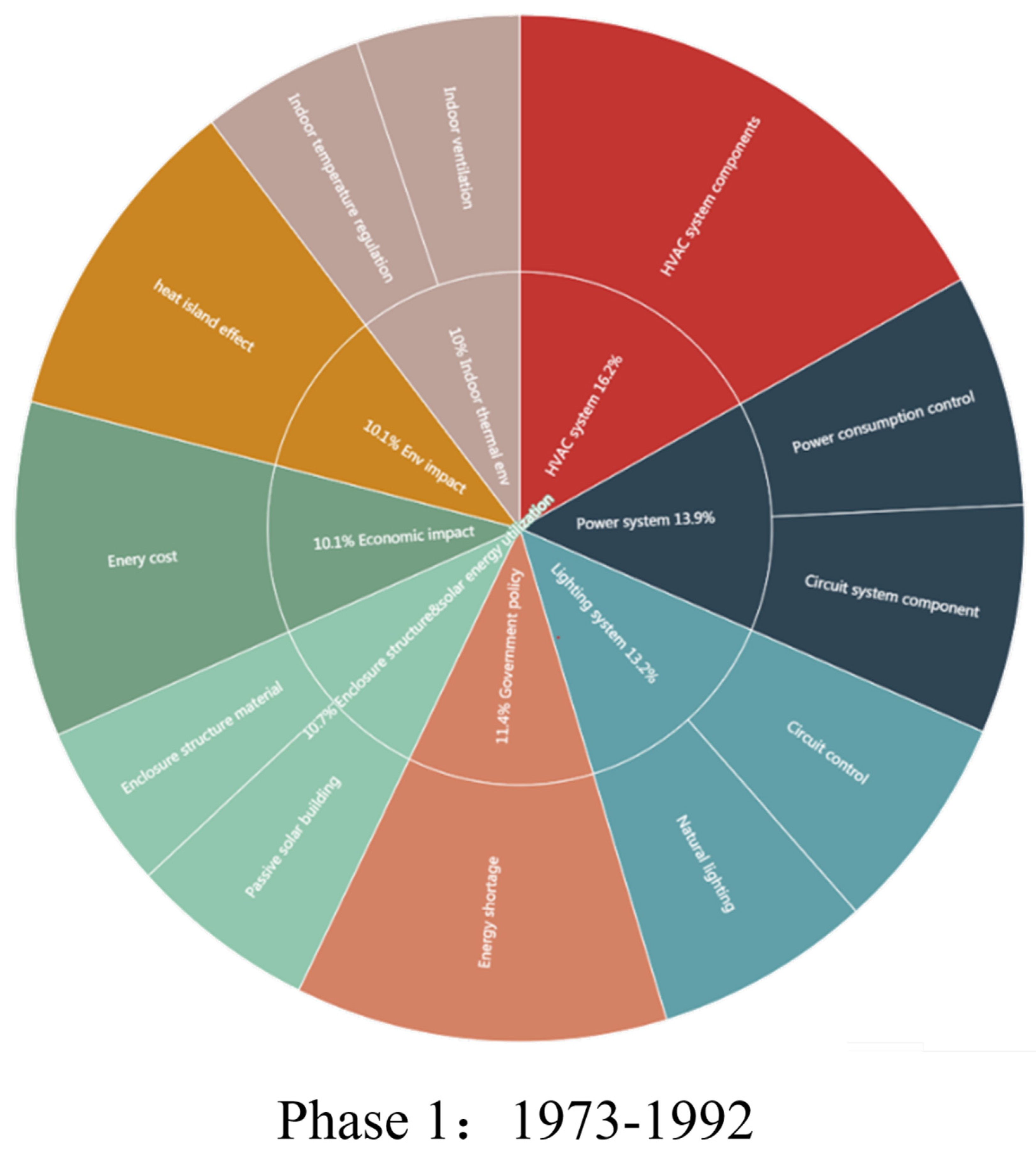

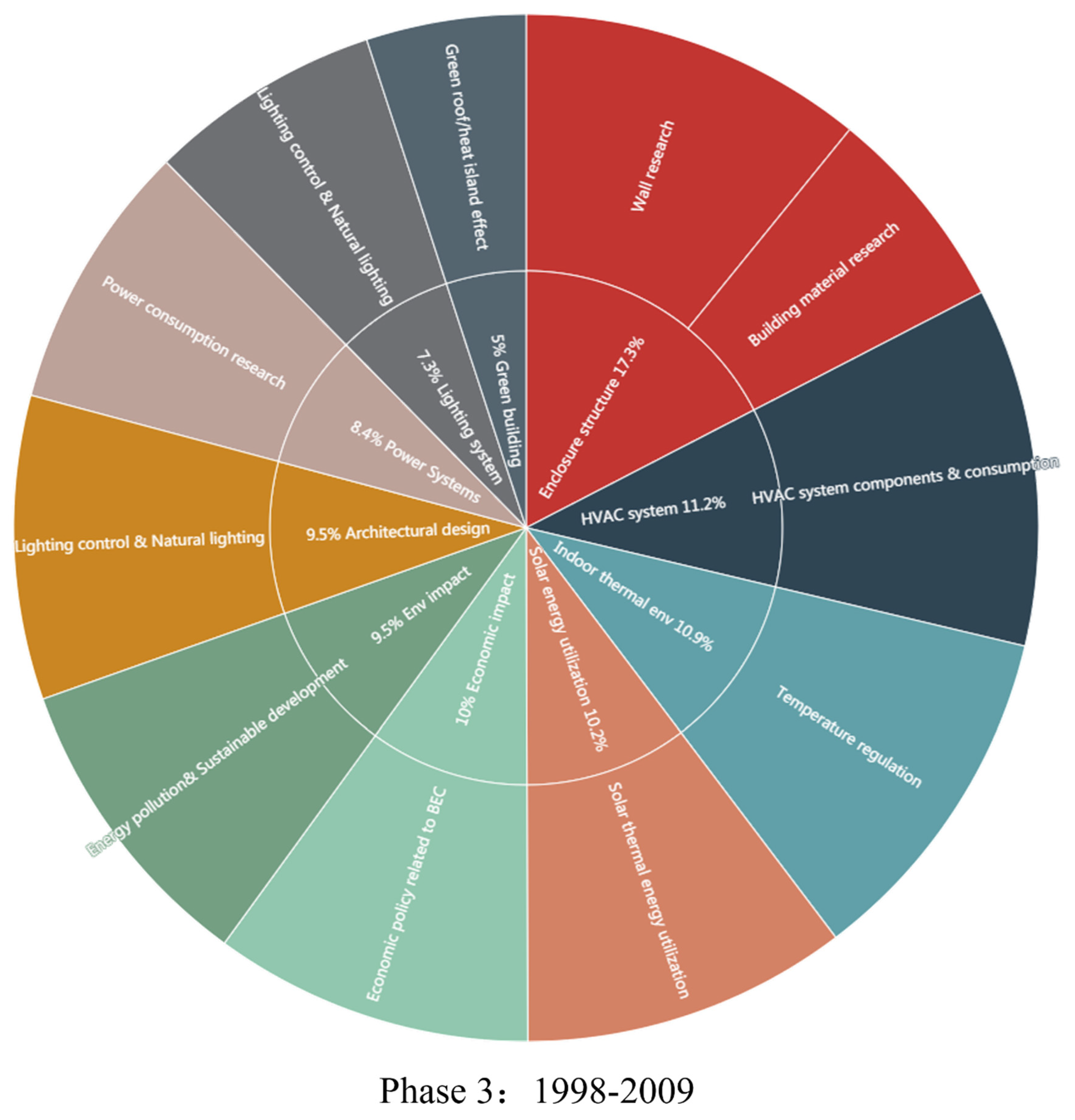
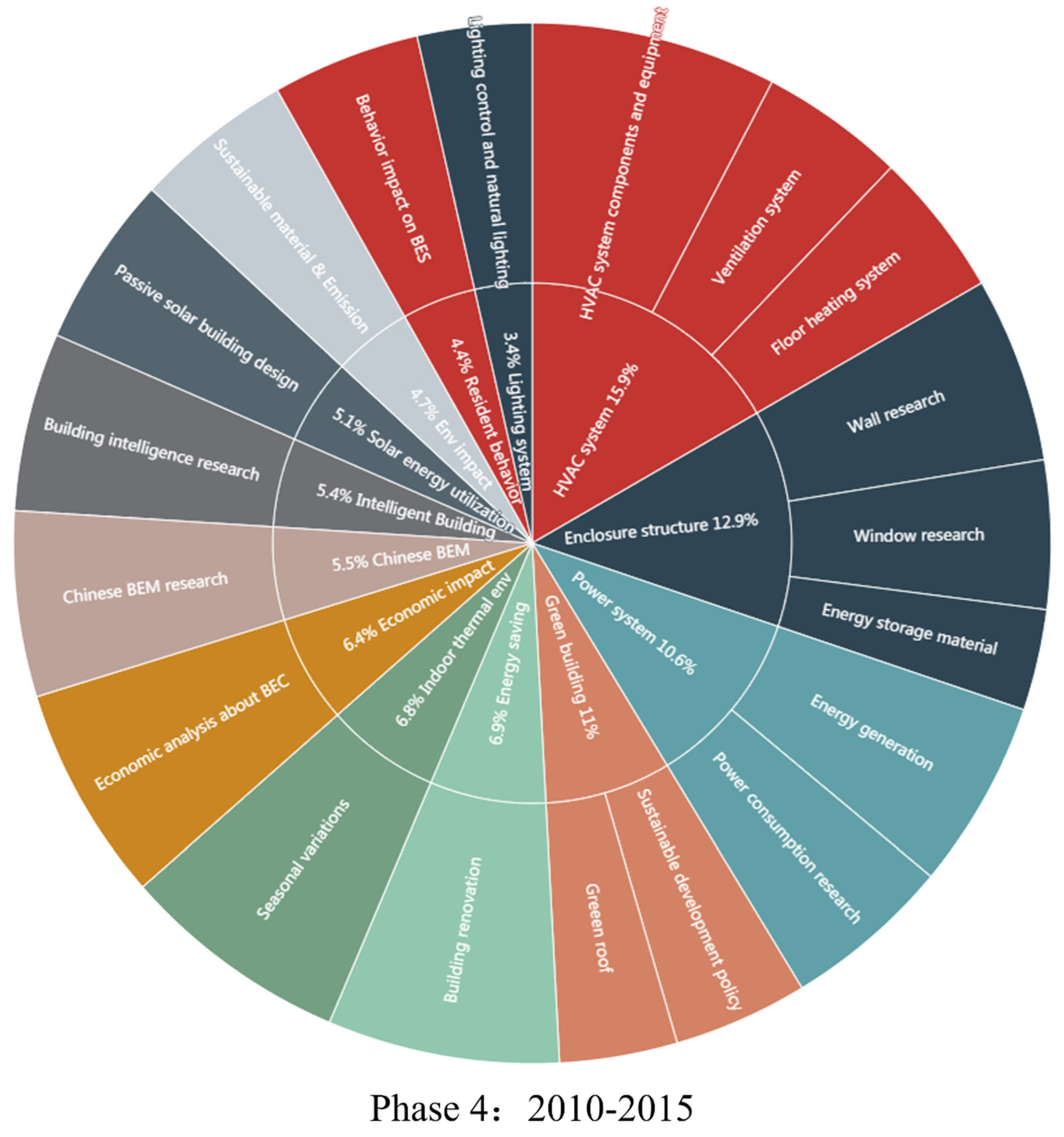
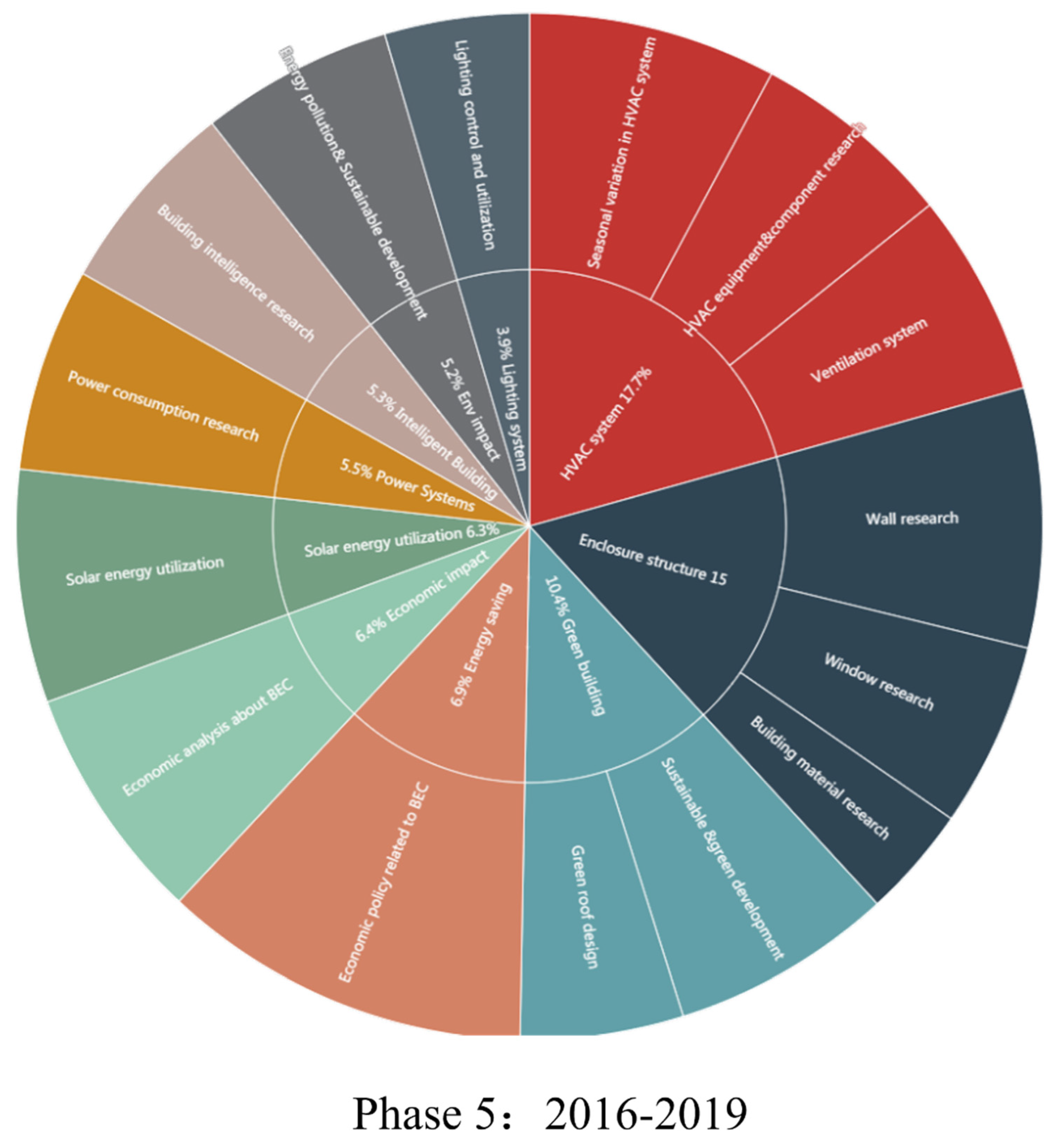
Appendix B. Comprehensive Thematic Network Graph
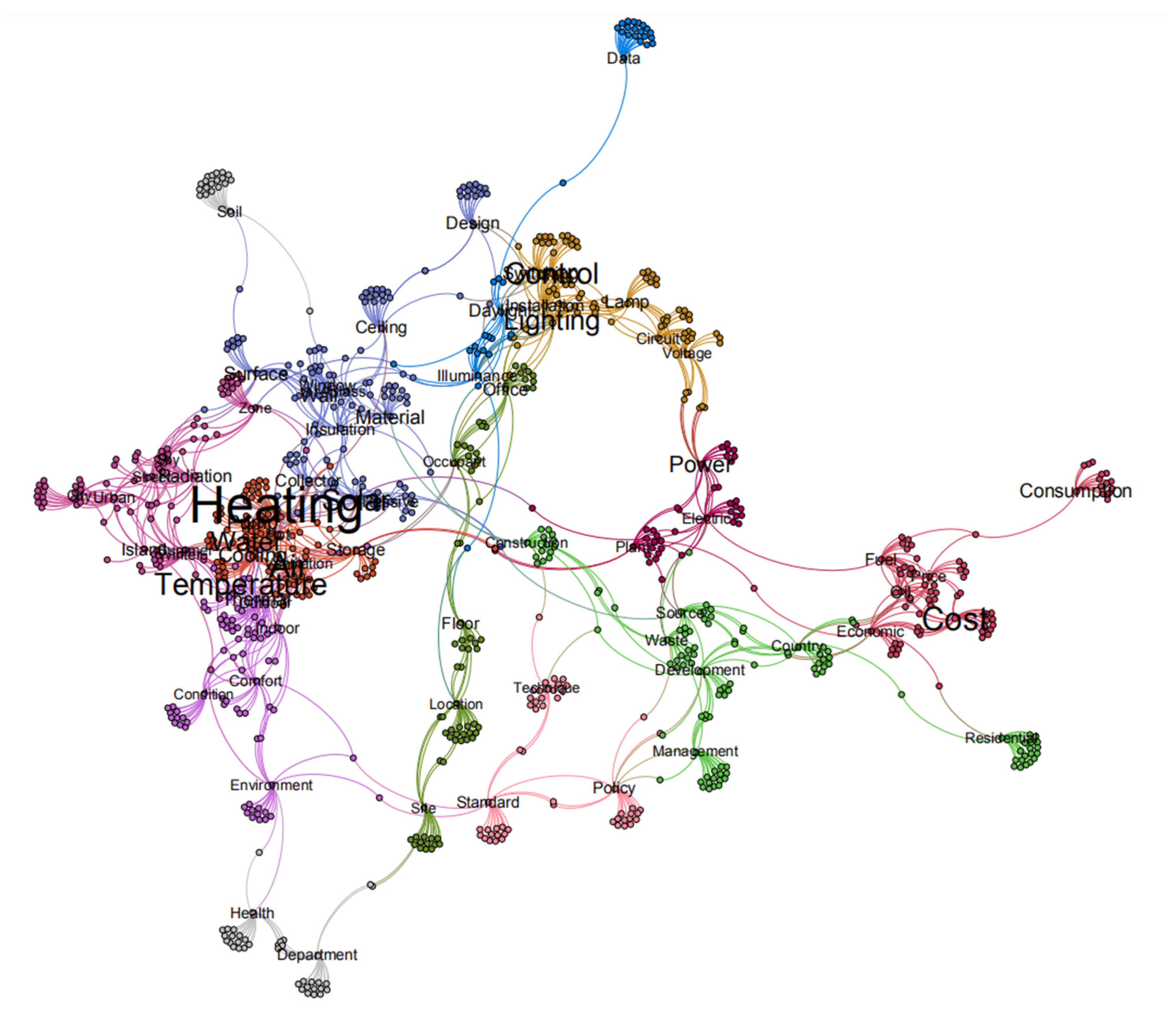
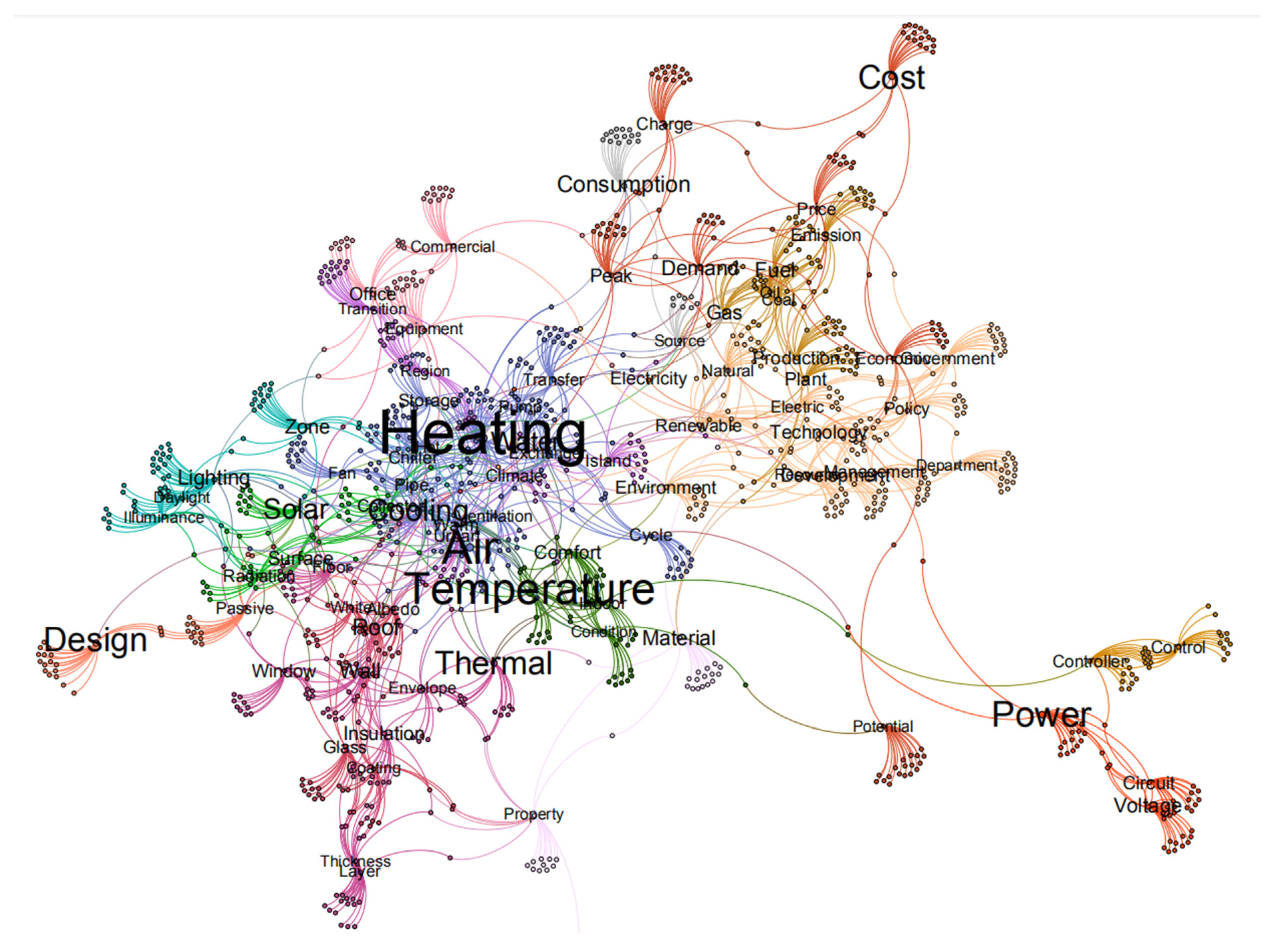

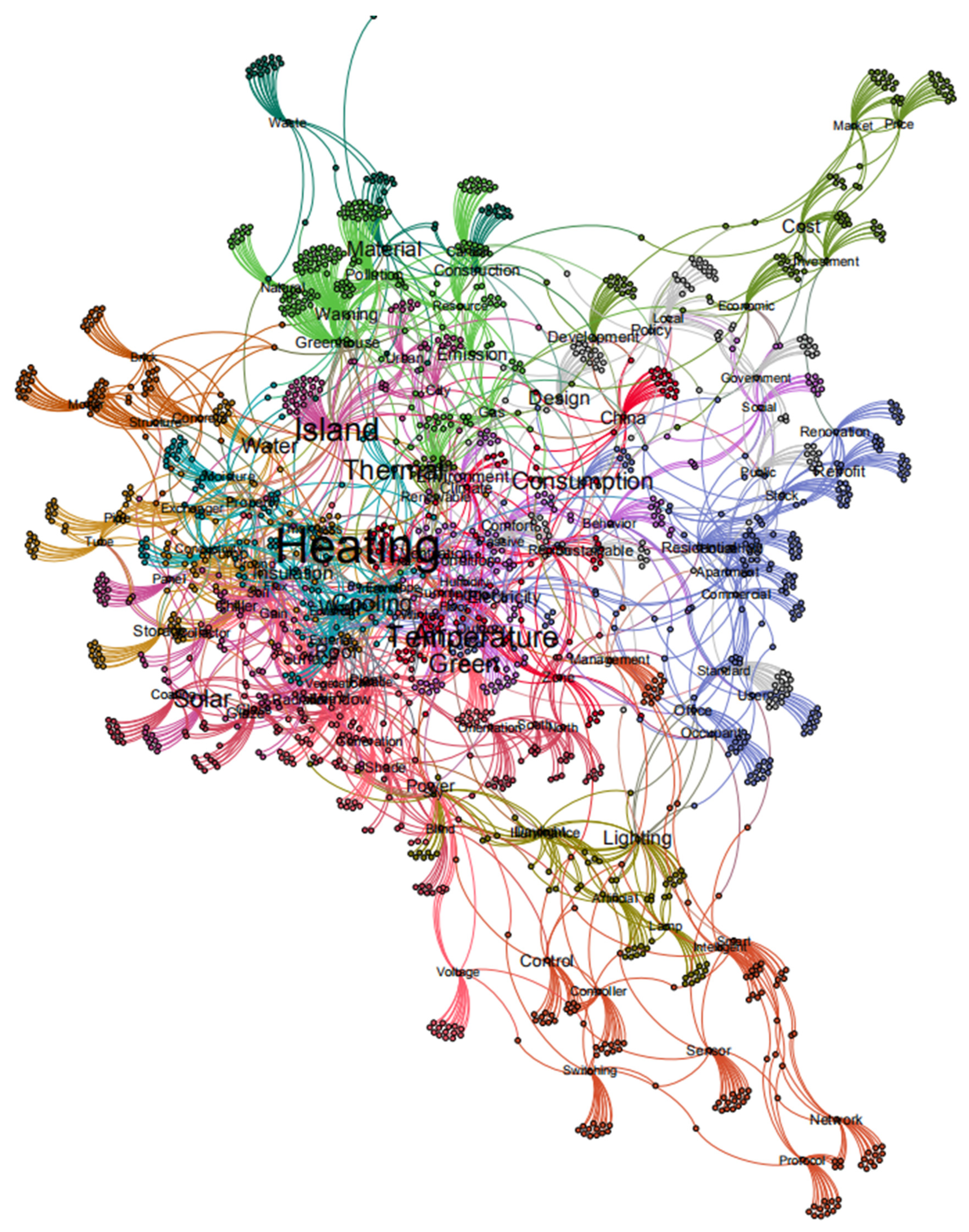

References
- Broecker, W. Climatic Change: Are We on the Brink of a Pronounced Global Warming? Science 1975, 189, 460–463. [Google Scholar] [CrossRef] [PubMed]
- Lotfabadi, P. Analyzing passive solar strategies in the case of high-rise building. Renew. Sustain. Energy Rev. 2015, 52, 1340–1353. [Google Scholar] [CrossRef]
- IEA, P.P. Modernising Building Energy Codes; OECD/IEA and UNDP Paris Cedex: New York, NY, USA, 2013. [Google Scholar]
- Cao, X.D.; Dai, X.L.; Liu, J.J. Building energy-consumption status worldwide and the state-of-the-art technologies for zero-energy buildings during the past decade. Energy Build. 2016, 128, 198–213. [Google Scholar] [CrossRef]
- Mason, K.; Grijalva, S. A review of reinforcement learning for autonomous building energy management. Comput. Electr. Eng. 2019, 78, 300–312. [Google Scholar] [CrossRef]
- Tranfield, D.; Denyer, D.; Smart, P. Towards a Methodology for Developing Evidence-Informed Management Knowledge by Means of Systematic Review. Br. J. Manag. 2003, 14, 207–222. [Google Scholar] [CrossRef]
- Chen, S.; Zhang, G.; Xia, X.; Setunge, S.; Shi, L. A review of internal and external influencing factors on energy efficiency design of buildings. Energy Build. 2020, 216, 109944. [Google Scholar] [CrossRef]
- Ngarambe, J.; Yun, G.Y.; Santamouris, M. The use of artificial intelligence (AI) methods in the prediction of thermal comfort in buildings: Energy implications of AI-based thermal comfort controls. Energy Build. 2020, 211, 109807. [Google Scholar] [CrossRef]
- Dubois, M.C.; Blomsterberg, Å. Energy saving potential and strategies for electric lighting in future North European, low energy office buildings: A literature review. Energy Build. 2011, 43, 2572–2582. [Google Scholar] [CrossRef]
- Montoya, F.G.; Peña-García, A.; Juaidi, A.; Manzano-Agugliaro, F. Indoor lighting techniques: An overview of evolution and new trends for energy saving. Energy Build. 2017, 140, 50–60. [Google Scholar] [CrossRef]
- Guyot, G.; Sherman, M.H.; Walker, I.S. Smart ventilation energy and indoor air quality performance in residential buildings: A review. Energy Build. 2018, 165, 416–430. [Google Scholar] [CrossRef]
- Chenari, B.; Dias Carrilho, J.; Gameiro da Silva, M. Towards sustainable, energy-efficient and healthy ventilation strategies in buildings: A review. Renew. Sustain. Energy Rev. 2016, 59, 1426–1447. [Google Scholar] [CrossRef]
- Wong, I.; Baldwin, A.N. Investigating the potential of applying vertical green walls to high-rise residential buildings for energy-saving in sub-tropical region. Build. Environ. 2016, 97, 34–39. [Google Scholar] [CrossRef]
- Shameri, M.A.; Alghoul, M.A.; Sopian, K.; Zain, M.F.M.; Elayeb, O. Perspectives of double skin façade systems in buildings and energy saving. Renew. Sustain. Energy Rev. 2011, 15, 1468–1475. [Google Scholar] [CrossRef]
- Choi, H.S.; Lee, W.S.; Sohn, S.Y. Analyzing research trends in personal information privacy using topic modeling. Comput. Secur. 2017, 67, 244–253. [Google Scholar] [CrossRef]
- Cooper, H.M. Organizing knowledge syntheses: A taxonomy of literature reviews. Knowl. Soc. 1988, 1, 104. [Google Scholar] [CrossRef]
- Korhonen, A.; Séaghdha, D.O.; Silins, I.; Sun, L.; Högberg, J.; Stenius, U. Text mining for literature review and knowledge discovery in cancer risk assessment and research. PLoS ONE 2012, 7, e33427. [Google Scholar] [CrossRef]
- Kang, M.; Ahn, J.; Lee, K. Opinion mining using ensemble text hidden Markov models for text classification. Expert Syst. Appl. 2018, 94, 218–227. [Google Scholar] [CrossRef]
- Griffiths, T.L.; Steyvers, M. Finding scientific topics. Proc. Natl. Acad. Sci. USA 2004, 101, 5228–5235. [Google Scholar] [CrossRef]
- Xiong, H.; Cheng, Y.; Zhao, W.H.; Liu, J.H. Analyzing scientific research topics in manufacturing field using a topic model. Comput. Ind. Eng. 2019, 135, 333–347. [Google Scholar] [CrossRef]
- Jiang, H.C.; Qiang, M.S.; Lin, P. A topic modeling based bibliometric exploration of hydropower research. Renew. Sustain. Energy Rev. 2016, 57, 226–237. [Google Scholar] [CrossRef]
- Yang, X.; Xu, S.; Wu, H.; Bie, R. Sentiment Analysis of Weibo Comment Texts Based on Extended Vocabulary and Convolutional Neural Network. Procedia Comput. Sci. 2019, 147, 361–368. [Google Scholar] [CrossRef]
- Nawangsari, R.P.; Kusumaningrum, R.; Wibowo, A. Word2Vec for Indonesian Sentiment Analysis towards Hotel Reviews: An Evaluation Study. Procedia Comput. Sci. 2019, 157, 360–366. [Google Scholar] [CrossRef]
- Nguyen, T.; Larsen, M.E.; O’Dea, B.; Phung, D.; Venkatesh, S.; Christensen, H. Estimation of the prevalence of adverse drug reactions from social media. Int. J. Med. Inform. 2017, 102, 130–137. [Google Scholar] [CrossRef] [PubMed]
- Gobster, P.H. (Text) Mining the LANDscape: Themes and trends over 40 years of Landscape and Urban Planning. Landsc. Urban Plan. 2014, 126, 21–30. [Google Scholar] [CrossRef]
- Zou, X.; Yue, W.L.; Vu, H.L. Visualization and analysis of mapping knowledge domain of road safety studies. Accid. Anal. Prev. 2018, 118, 131–145. [Google Scholar] [CrossRef] [PubMed]
- Awruch, C.A.; Somoza, G.M.; Baldock, C. Chondrichthyan research in South America: Endocrinology overview and research trends over 50 years (1967–2016) compared to the rest of the world. Gen. Comp. Endocrinol. 2019, 273, 118–133. [Google Scholar] [CrossRef] [PubMed]
- Blei, D.M.; Ng, A.Y.; Jordan, M.I. Latent dirichlet allocation. J. Mach. Learn. Res. 2012, 3, 993–1022. [Google Scholar]
- Rumelhart, D.E.; Hinton, G.E.; Williams, R.J. Learning Representations by Back-Propagating Errors. Nature 1986, 323, 533–536. [Google Scholar] [CrossRef]
- Newman, M.E. Modularity and community structure in networks. Proc. Natl. Acad. Sci. USA 2006, 103, 8577–8582. [Google Scholar] [CrossRef]
- Newman, M.E. Fast algorithm for detecting community structure in networks. Phys. Rev. E Stat. Nonlinear Soft Matter Phys. 2004, 69, 066133. [Google Scholar] [CrossRef]
- Blondel, V.D.; Guillaume, J.L.; Lambiotte, R.; Lefebvre, E. Fast unfolding of communities in large networks. J. Stat. Mech. Theory E 2008, 2008, 155–168. [Google Scholar] [CrossRef]
- Mimno, D.M.; Wallach, H.M.; Talley, E.M.; Leenders, M.; Mccallum, A. Optimizing Semantic Coherence in Topic Models, Proceedings of the 2011 Conference on Empirical Methods in Natural Language Processing, EMNLP 2011, Edinburgh, UK, 27–31 July 2011; A Meeting of SIGDAT, a Special Interest Group of the ACL; John McIntyre Conference Centre: Edinburgh, UK, 2011. [Google Scholar]
- Moezzi, M.; Goins, J. Text mining for occupant perspectives on the physical workplace. Build. Res. Inf. 2011, 39, 169–182. [Google Scholar] [CrossRef]
- Wu, T.; Green, F.; Lu, J.; Qi, Y.; Stern, N. China’s post-coal growth. Nat. Geosci. 2016, 9, 564–566. [Google Scholar]
- Yun, G.Y. Influences of perceived control on thermal comfort and energy use in buildings. Energy Build. 2018, 158, 822–830. [Google Scholar] [CrossRef]
- Afram, A.; Fung, A.S.; Janabi-Sharifi, F.; Raahemifar, K. Development of an accurate gray-box model of ubiquitous residential HVAC system for precise performance prediction during summer and winter seasons. Energy Build. 2018, 171, 168–182. [Google Scholar] [CrossRef]
- Li, D.; He, J.; Li, L. A review of renewable energy applications in buildings in the hot-summer and warm-winter region of China. Renew. Sustain. Energy Rev. 2016, 57, 327–336. [Google Scholar] [CrossRef]
- Liu, H.; Kojima, S. Evaluation on the Energy Consumption and Thermal Performance in Different Residential Building Types During Mid-season in Hot-summer and Cold-winter Zone in China. Procedia Eng. 2017, 180, 282–291. [Google Scholar] [CrossRef]
- Bughrara, K.S.M.; Arsan, Z.D.; Akkurt, G.G. Applying underfloor heating system for improvement of thermal comfort in historic mosques: The case study of Salepçioğlu Mosque, Izmir, Turkey. Energy Procedia 2017, 133, 290–299. [Google Scholar] [CrossRef]
- Ma, H.; Li, C.; Lu, W.; Zhang, Z.; Yu, S.; Du, N. Investigation on a solar-groundwater heat pump unit associated with radiant floor heating. Renew. Sustain. Energy Rev. 2017, 75, 972–977. [Google Scholar] [CrossRef]
- Papakostas, K.T.; Slini, T. Effects of Climate Change on the Energy Required for the Treatment of Ventilation Fresh Air in HVAC Systems the Case of Athens and Thessaloniki. Procedia Environ. Sci. 2017, 38, 852–859. [Google Scholar] [CrossRef]
- Sadineni, S.B.; Madala, S.; Boehm, R.F. Passive building energy savings: A review of building envelope components. Renew. Sustain. Energy Rev. 2011, 15, 3617–3631. [Google Scholar] [CrossRef]
- Gholami, H.; Røstvik, H.N. Economic analysis of BIPV systems as a building envelope material for building skins in Europe. Energy 2020, 204, 117931. [Google Scholar] [CrossRef]
- Abdallah, M.; Abu Talib, M.; Feroz, S.; Nasir, Q.; Abdalla, H.; Mahfood, B. Artificial intelligence applications in solid waste management: A systematic research review. Waste Manag. 2020, 109, 231–246. [Google Scholar] [CrossRef]
- Martínez-Molina, A.; Tort-Ausina, I.; Cho, S.; Vivancos, J.L. Energy efficiency and thermal comfort in historic buildings: A review. Renew. Sustain. Energy Rev. 2016, 61, 70–85. [Google Scholar] [CrossRef]
- Huide, F.; Xuxin, Z.; Lei, M.; Tao, Z.; Qixing, W.; Hongyuan, S. A comparative study on three types of solar utilization technologies for buildings: Photovoltaic, solar thermal and hybrid photovoltaic/thermal systems. Energy Convers. Manag. 2017, 140, 1–13. [Google Scholar] [CrossRef]
- Ralegaonkar, R.V.; Gupta, R. Review of intelligent building construction: A passive solar architecture approach. Renew. Sustain. Energy Rev. 2010, 14, 2238–2242. [Google Scholar] [CrossRef]
- Tong, G.; Christopher, D.M.; Li, T.; Wang, T. Passive solar energy utilization: A review of cross-section building parameter selection for Chinese solar greenhouses. Renew. Sustain. Energy Rev. 2013, 26, 540–548. [Google Scholar] [CrossRef]
- Gago, E.J.; Muneer, T.; Knez, M.; Köster, H. Natural light controls and guides in buildings. Energy saving for electrical lighting, reduction of cooling load. Renew. Sustain. Energy Rev. 2015, 41, 1–13. [Google Scholar] [CrossRef]
- Wagiman, K.R.; Abdullah, M.N.; Hassan, M.Y.; Mohammad Radzi, N.H.; Abu Bakar, A.H.; Kwang, T.C. Lighting system control techniques in commercial buildings: Current trends and future directions. J. Build. Eng. 2020, 31, 101342. [Google Scholar] [CrossRef]
- Pandharipande, A.; Caicedo, D. Smart indoor lighting systems with luminaire-based sensing: A review of lighting control approaches. Energy Build. 2015, 104, 369–377. [Google Scholar] [CrossRef]
- Spyropoulos, G.N.; Balaras, C.A. Energy consumption and the potential of energy savings in Hellenic office buildings used as bank branches—A case study. Energy Build. 2011, 43, 770–778. [Google Scholar] [CrossRef]
- Filippín, C.; Larsen, S.F.; Canori, M. Energy consumption of bioclimatic buildings in Argentina during the period 2001–2008. Renew. Sustain. Energy Rev. 2010, 14, 1216–1228. [Google Scholar] [CrossRef]
- Mbungu, N.T.; Naidoo, R.M.; Bansal, R.C.; Siti, M.W.; Tungadio, D.H. An overview of renewable energy resources and grid integration for commercial building applications. J. Energy Storage 2020, 29, 101385. [Google Scholar] [CrossRef]
- Enongene, K.E.; Murray, P.; Holland, J.; Abanda, F.H. Energy savings and economic benefits of transition towards efficient lighting in residential buildings in Cameroon. Renew. Sustain. Energy Rev. 2017, 78, 731–742. [Google Scholar] [CrossRef]
- Gustafsson, M.; Dipasquale, C.; Poppi, S.; Bellini, A.; Fedrizzi, R.; Bales, C.; Ochs, F.; Sié, M.; Holmberg, S. Economic and environmental analysis of energy renovation packages for European office buildings. Energy Build. 2017, 148, 155–165. [Google Scholar] [CrossRef]
- Li, X.; Zhou, Y.; Yu, S.; Jia, G.; Li, H.; Li, W. Urban heat island impacts on building energy consumption: A review of approaches and findings. Energy 2019, 174, 407–419. [Google Scholar] [CrossRef]
- Yang, X.; Peng, L.L.H.; Jiang, Z.; Chen, Y.; Yao, L.; He, Y.; Xu, T. Impact of urban heat island on energy demand in buildings: Local climate zones in Nanjing. Appl. Energy 2020, 260, 114279. [Google Scholar] [CrossRef]
- Geng, Y.; Ji, W.; Wang, Z.; Lin, B.; Zhu, Y. A review of operating performance in green buildings: Energy use, indoor environmental quality and occupant satisfaction. Energy Build. 2019, 183, 500–514. [Google Scholar] [CrossRef]
- Zhang, C.; Cui, C.; Zhang, Y.; Yuan, J.; Luo, Y.; Gang, W. A review of renewable energy assessment methods in green building and green neighborhood rating systems. Energy Build. 2019, 195, 68–81. [Google Scholar] [CrossRef]
- Susca, T. Green roofs to reduce building energy use? A review on key structural factors of green roofs and their effects on urban climate. Build. Environ. 2019, 162, 106273. [Google Scholar] [CrossRef]
- Castleton, H.F.; Stovin, V.; Beck, S.B.M.; Davison, J.B. Green roofs; building energy savings and the potential for retrofit. Energy Build. 2010, 42, 1582–1591. [Google Scholar] [CrossRef]
- Rinaldi, A.; Schweiker, M.; Iannone, F. On uses of energy in buildings: Extracting influencing factors of occupant behaviour by means of a questionnaire survey. Energy Build. 2018, 168, 298–308. [Google Scholar] [CrossRef]
- Zhang, Y.; Bai, X.; Mills, F.P. Characterizing energy-related occupant behavior in residential buildings: Evidence from a survey in Beijing, China. Energy Build. 2020, 214, 109823. [Google Scholar] [CrossRef]
- Feng, X.; Yan, D.; Wang, C.; Sun, H. A preliminary research on the derivation of typical occupant behavior based on large-scale questionnaire surveys. Energy Build. 2016, 117, 332–340. [Google Scholar] [CrossRef]
- Zou, P.X.W.; Xu, X.; Sanjayan, J.; Wang, J. A mixed methods design for building occupants’ energy behavior research. Energy Build. 2018, 166, 239–249. [Google Scholar] [CrossRef]
- Andersen, S.; Andersen, R.K.; Olesen, B.W. Influence of heat cost allocation on occupants’ control of indoor environment in 56 apartments: Studied with measurements, interviews and questionnaires. Build. Environ. 2016, 101, 1–8. [Google Scholar] [CrossRef]
- Langevin, J.; Gurian, P.L.; Wen, J. Tracking the human-building interaction: A longitudinal field study of occupant behavior in air-conditioned offices. J. Environ. Psychol. 2015, 42, 94–115. [Google Scholar] [CrossRef]
- Wang, Y.; Kuckelkorn, J.; Zhao, F.Y.; Liu, D.; Kirschbaum, A.; Zhang, J.L. Evaluation on classIndoor thermal comfort and energy performance of passive school building by optimizing HVAC control systems. Build. Environ. 2015, 89, 86–106. [Google Scholar] [CrossRef]
- Shin, M.; Haberl, J.S. Thermal zoning for building HVAC design and energy simulation: A literature review. Energy Build. 2019, 203, 109429. [Google Scholar] [CrossRef]
- Griswold, B.W.; Hellickson, M.L. Heat-recovery using a water-to-water heat-pump in milking parlors. Trans. ASAE 1984, 27, 871–874. [Google Scholar] [CrossRef]
- Tiwari, G.N. Transient performance of a thermosyphon water heating-system with n-units connected in series. Sol. Energy 1985, 35, 371–375. [Google Scholar] [CrossRef]
- Mishra, R.S.; Bansal, N.K. Performance equations for air-heating and water-heating systems. Energy Convers. Manag. 1986, 26, 91–93. [Google Scholar] [CrossRef]
- Oliveti, G.; Arcuri, N.; Ruffolo, S. First experimental results from a prototype plant for the interseasonal storage of solar energy for the winter heating of buildings. Sol. Energy 1998, 62, 281–290. [Google Scholar] [CrossRef]
- Kenworthy, A. Climatic exposure and fuel consumption in high rise dwellings. Build. Environ. 1978, 13, 167–174. [Google Scholar] [CrossRef]
- Kenworthy, A.T. Observations on climate and building design with particular reference to building aerodynamics and its effects on fuel consumption in multi-storey dwellings. Energy Build. 1982, 4, 173–175. [Google Scholar] [CrossRef]
- Beggs, C.B.; Warwicker, B.; Howarth, A.T. Elimination of air conditioning in existing buildings through fabric thermal storage: Theoretical study. Build. Serv. Eng. Res. Technol. 1995, 16, 215–220. [Google Scholar] [CrossRef]
- Lam, J.C. Electricity consumption and built environment in air-conditioned buildings. Energy Eng. 1995, 92, 31–39. [Google Scholar]
- Lam, J.C.; Hui, S.C.M.; Chan, A.L.S. Regression analysis of high-rise fully air-conditioned office buildings. Energy Build. 1997, 26, 189–197. [Google Scholar] [CrossRef]
- Zhang, Y.; Barber, E.M. Air leakage and ventilation effectiveness for confinement livestock housing. Trans. ASAE 1995, 38, 1501–1504. [Google Scholar] [CrossRef]
- Hanna, G.B. Effect of variable ventilation timing on the estimated temperature of an enclosure. Build. Environ. 1978, 13, 243–250. [Google Scholar] [CrossRef]
- Kheiri, F. A review on optimization methods applied in energy-efficient building geometry and envelope design. Renew. Sustain. Energy Rev. 2018, 92, 897–920. [Google Scholar] [CrossRef]
- Futrell, B.J.; Ozelkan, E.C.; Brentrup, D. Bi-objective optimization of building enclosure design for thermal and lighting performance. Build. Environ. 2015, 92, 591–602. [Google Scholar] [CrossRef]
- Akeiber, H.; Nejat, P.; Majid, M.Z.A.; Wahid, M.A.; Jomehzadeh, F.; Zeynali Famileh, I.; Calautit, J.K.; Hughes, B.R.; Zaki, S.A. A review on phase change material (PCM) for sustainable passive cooling in building envelopes. Renew. Sustain. Energy Rev. 2016, 60, 1470–1497. [Google Scholar] [CrossRef]
- Liu, Z.; Yu, Z.; Yang, T.; Qin, D.; Li, S.; Zhang, G.; Haghighat, F.; Joybari, M.M. A review on macro-encapsulated phase change material for building envelope applications. Build. Environ. 2018, 144, 281–294. [Google Scholar] [CrossRef]
- Lowry, G. Energy saving claims for lighting controls in commercial buildings. Energy Build. 2016, 133, 489–497. [Google Scholar] [CrossRef]
- Chew, I.; Karunatilaka, D.; Tan, C.P.; Kalavally, V. Smart lighting: The way forward? Reviewing the past to shape the future. Energy Build. 2017, 149, 180–191. [Google Scholar] [CrossRef]
- Yoshino, H.; Hong, T.; Nord, N. IEA EBC annex 53: Total energy use in buildings—Analysis and evaluation methods. Energy Build. 2017, 152, 124–136. [Google Scholar] [CrossRef]
- Kim, J.; Hong, T.; Jeong, J.; Lee, M.; Lee, M.; Jeong, K.; Koo, C.; Jeong, J. Establishment of an optimal occupant behavior considering the energy consumption and indoor environmental quality by region. Appl. Energy 2017, 204, 1431–1443. [Google Scholar] [CrossRef]
- D’Oca, S.; Chen, C.F.; Hong, T.; Belafi, Z. Synthesizing building physics with social psychology: An interdisciplinary framework for context and occupant behavior in office buildings. Energy Res. Soc. Sci. 2017, 34, 240–251. [Google Scholar] [CrossRef]
- Heydarian, A.; McIlvennie, C.; Arpan, L.; Yousefi, S.; Syndicus, M.; Schweiker, M.; Jazizadeh, F.; Rissetto, R.; Pisello, A.L.; Piselli, C.; et al. What drives our behaviors in buildings? A review on occupant interactions with building systems from the lens of behavioral theories. Build. Environ. 2020, 179, 106928. [Google Scholar] [CrossRef]
- Zhang, Y.; Bai, X.; Mills, F.P.; Pezzey, J.C.V. Rethinking the role of occupant behavior in building energy performance: A review. Energy Build. 2018, 172, 279–294. [Google Scholar] [CrossRef]
- Yousefi, F.; Gholipour, Y.; Yan, W. A study of the impact of occupant behaviors on energy performance of building envelopes using occupants’ data. Energy Build. 2017, 148, 182–198. [Google Scholar] [CrossRef]
- Ahn, K.U.; Park, C. Correlation between occupants and energy consumption. Energy Build. 2016, 116, 420–433. [Google Scholar] [CrossRef]
- Nguyen, T.A.; Aiello, M. Energy intelligent buildings based on user activity: A survey. Energy Build. 2013, 56, 244–257. [Google Scholar] [CrossRef]
- AlFaris, F.; Juaidi, A.; Manzano-Agugliaro, F. Intelligent homes’ technologies to optimize the energy performance for the net zero energy home. Energy Build. 2017, 153, 262–274. [Google Scholar] [CrossRef]
- Bai, L.; Yang, L.; Song, B.; Liu, N. A new approach to develop a climate classification for building energy efficiency addressing Chinese climate characteristics. Energy 2020, 195, 116982. [Google Scholar] [CrossRef]
- Bai, L.; Wang, S. Definition of new thermal climate zones for building energy efficiency response to the climate change during the past decades in China. Energy 2019, 170, 709–719. [Google Scholar] [CrossRef]
- Niu, S.; Zhang, X.; Zhao, C.; Niu, Y. Variations in energy consumption and survival status between rural and urban households: A case study of the Western Loess Plateau, China. Energy Policy 2012, 49, 515–527. [Google Scholar] [CrossRef]
- Zhang, M.; Song, Y.; Li, P.; Li, H. Study on affecting factors of residential energy consumption in urban and rural Jiangsu. Renew. Sustain. Energy Rev. 2016, 53, 330–337. [Google Scholar] [CrossRef]
- Cai, J.; Jiang, Z. Changing of energy consumption patterns from rural households to urban households in China: An example from Shaanxi Province, China. Renew. Sustain. Energy Rev. 2008, 12, 1667–1680. [Google Scholar] [CrossRef]
- Liu, Z.; Zhou, Q.; Tian, Z.; He, B.J.; Jin, G. A comprehensive analysis on definitions, development, and policies of nearly zero energy buildings in China. Renew. Sustain. Energy Rev. 2019, 114, 109314. [Google Scholar] [CrossRef]
- Liu, X.; Liu, X.; Luo, X.; Fu, H.; Wang, M.; Li, L. Impact of Different Policy Instruments on Diffusing Energy Consumption Monitoring Technology in Public Buildings: Evidence from Xi’ an, China. J. Clean. Prod. 2020, 251, 119693. [Google Scholar] [CrossRef]
- Li, J.; Shui, B. A comprehensive analysis of building energy efficiency policies in China: Status quo and development perspective. J. Clean. Prod. 2015, 90, 326–344. [Google Scholar] [CrossRef]


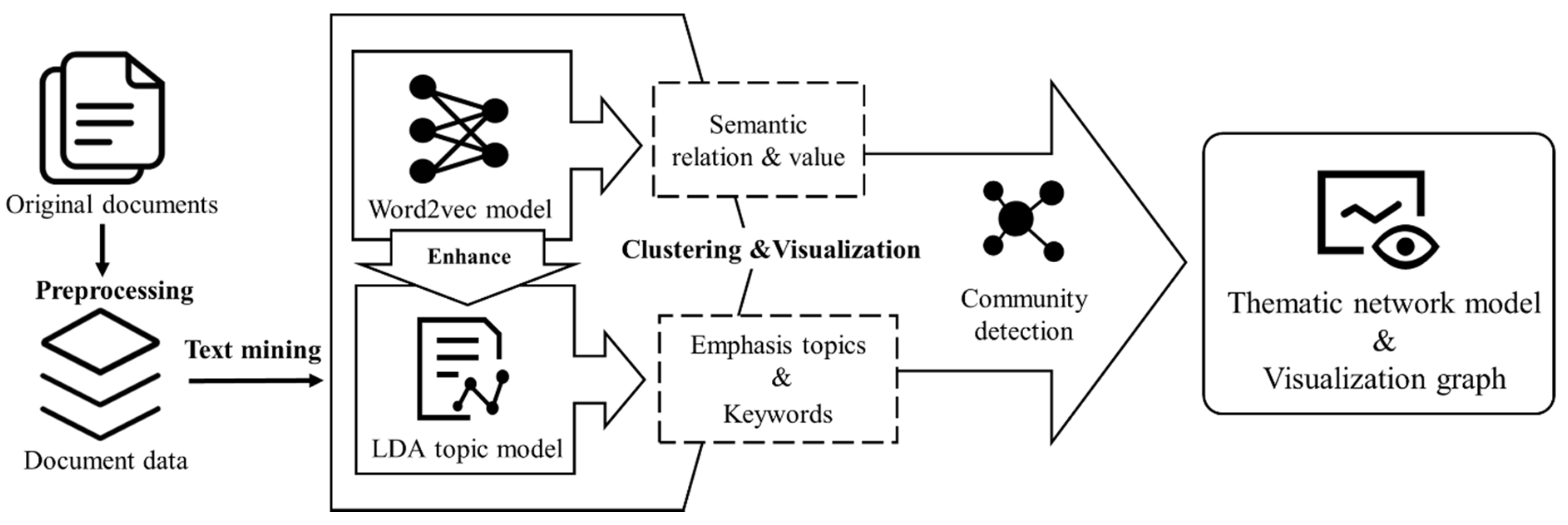
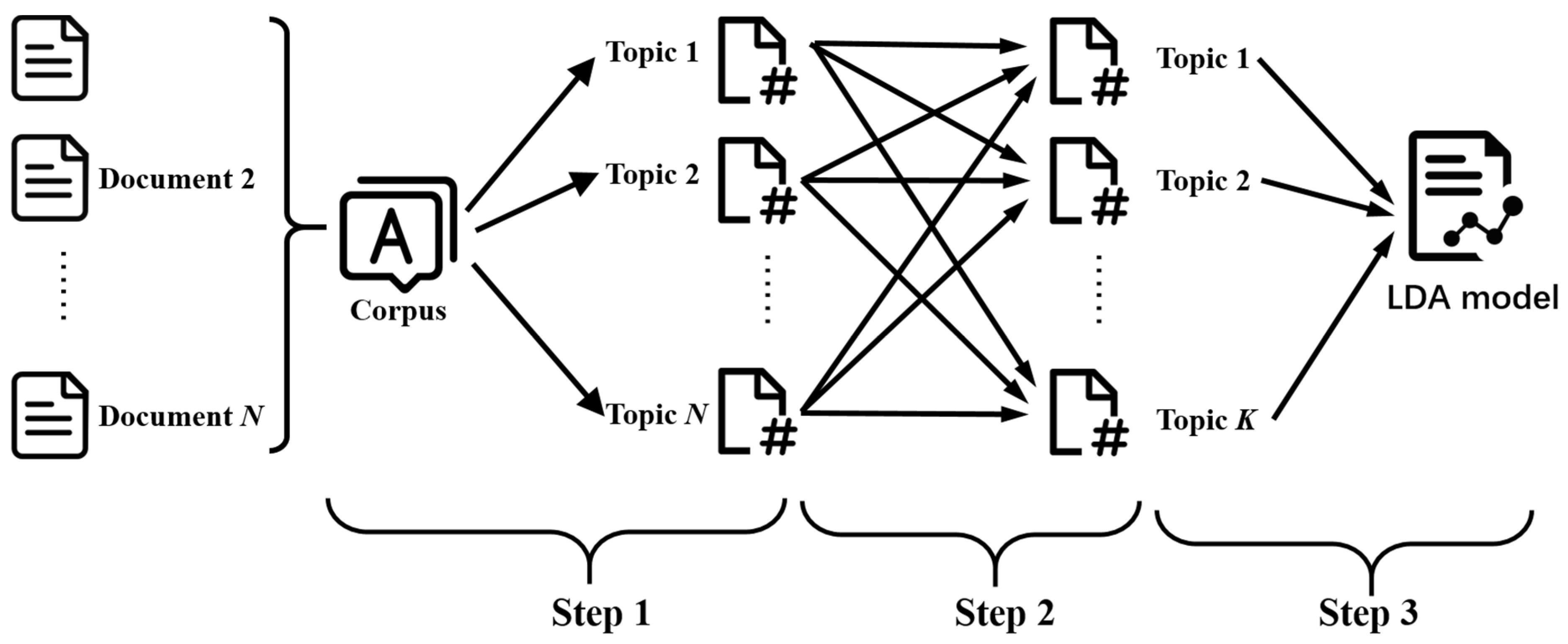

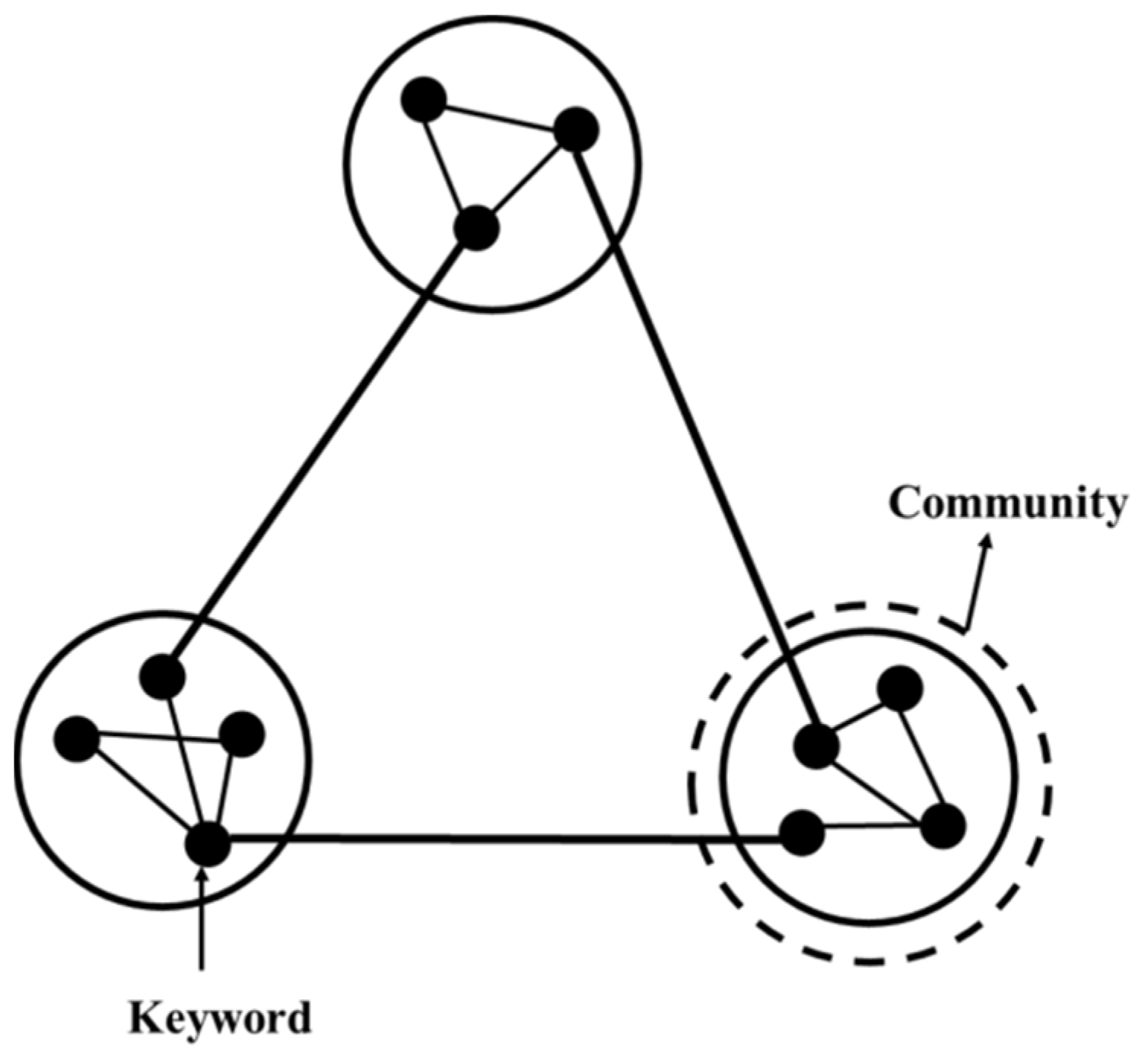
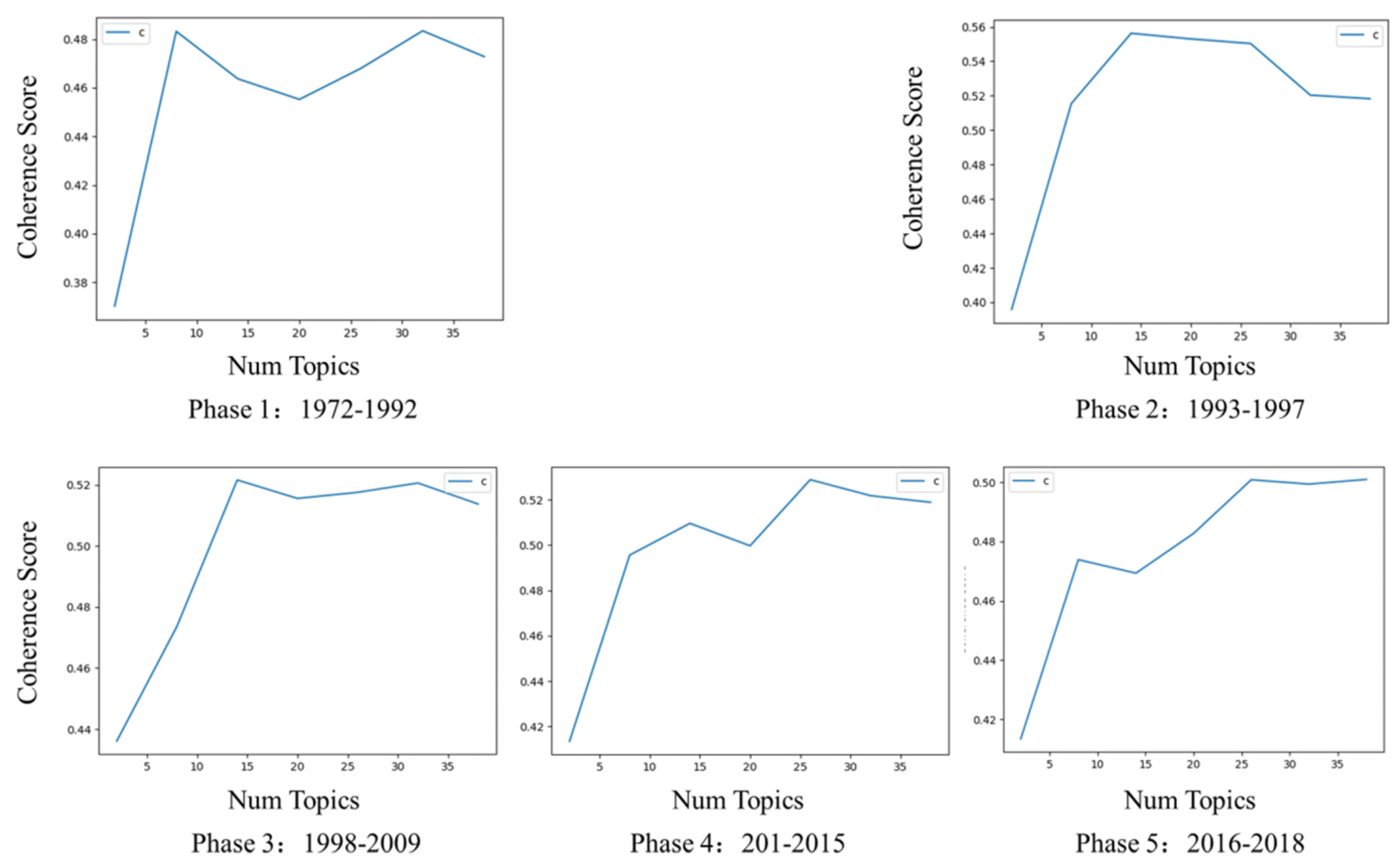
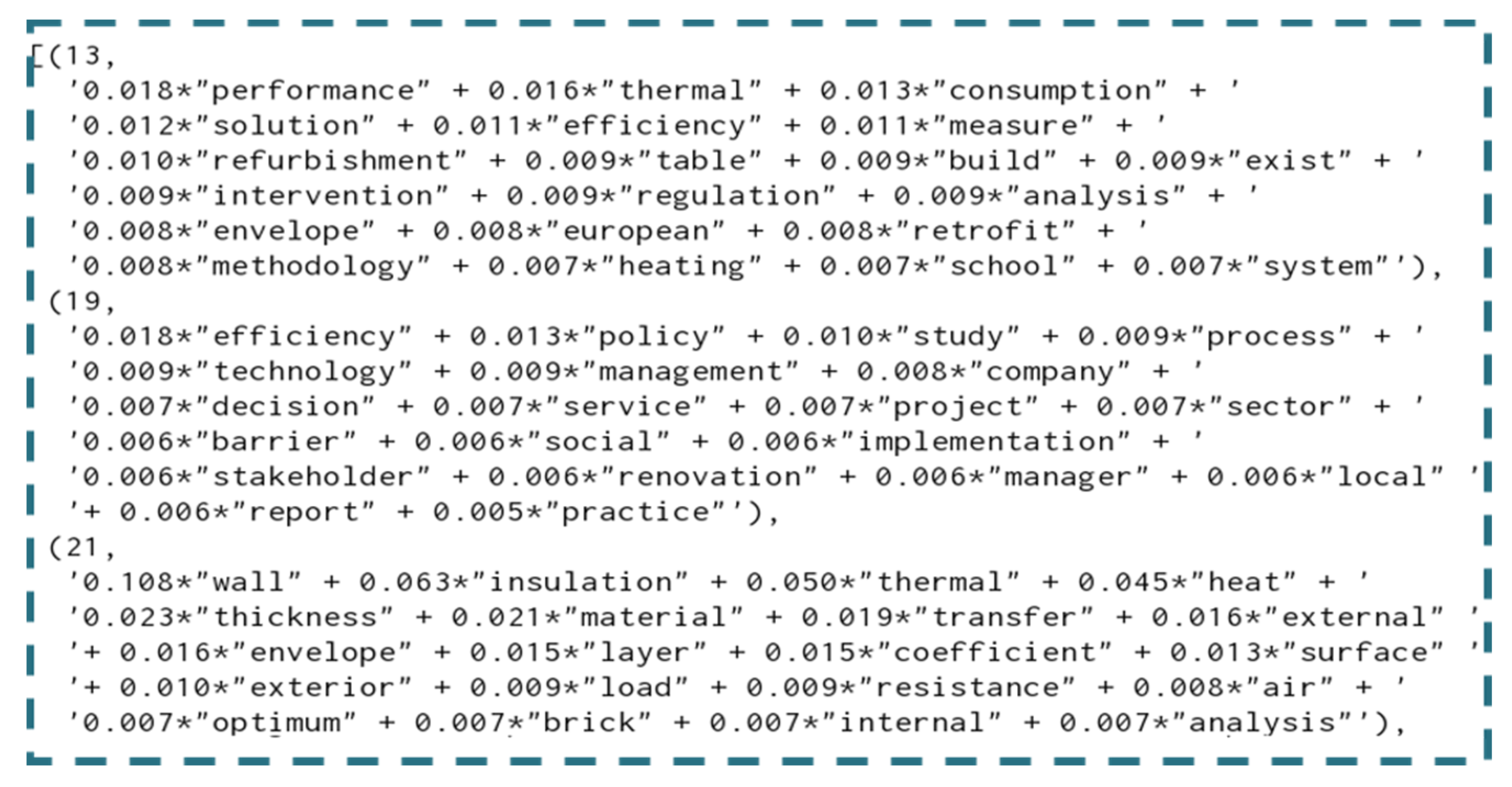
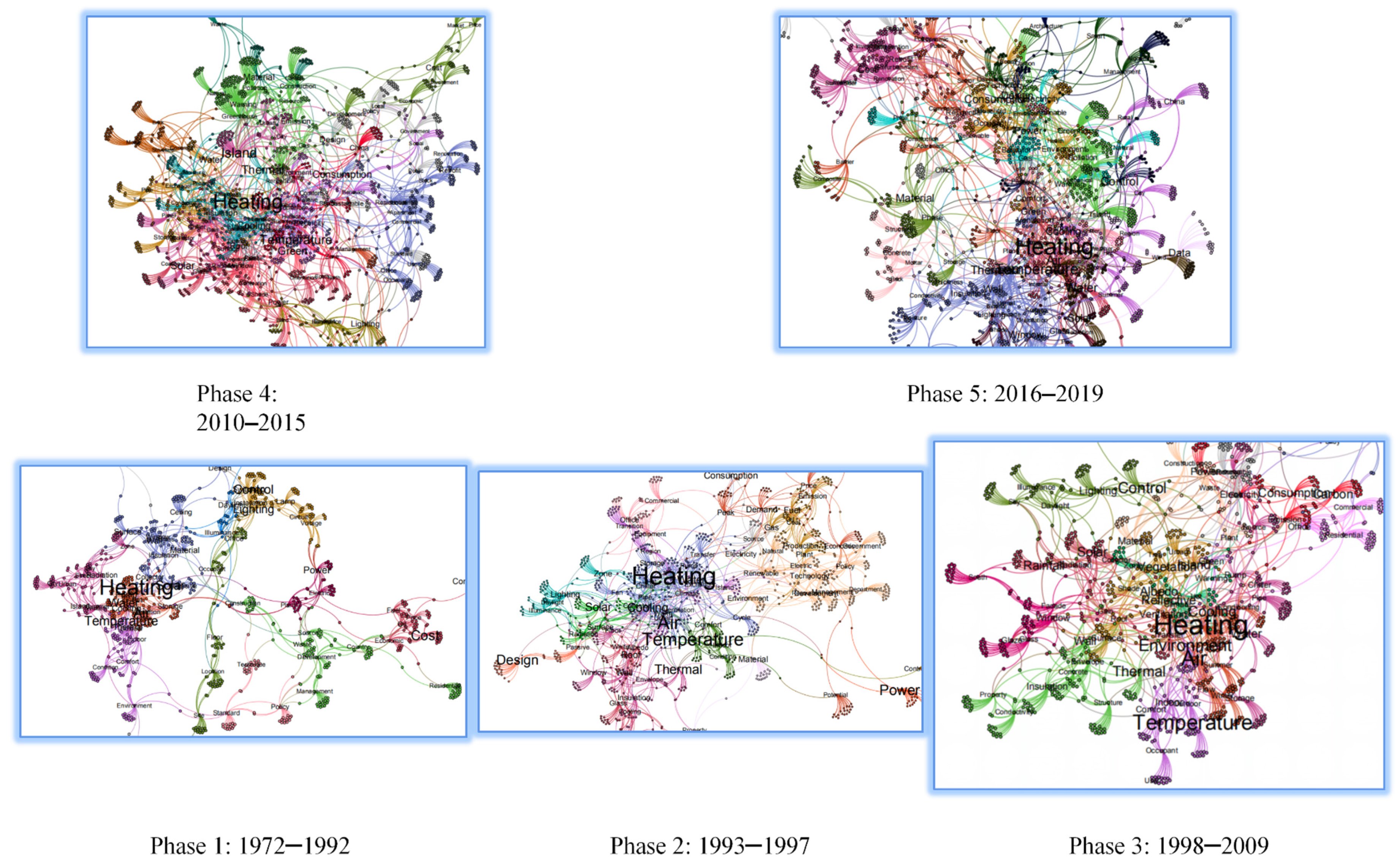

| Time Phase | Timestamp Event | Time Span | Number of Articles |
|---|---|---|---|
| Phase 1 | Energy crisis | 1972–1992 | 269 |
| Phase 2 | Rio Conference | 1993–1997 | 335 |
| Phase 3 | Tokyo Conference | 1998–2009 | 1213 |
| Phase 4 | Copenhagen Conference | 2010–2015 | 2340 |
| Phase 5 | Paris Meeting | 2016–2019 | 1555 |
| Phase | Optimal Number of Topics |
|---|---|
| Phase 1: 1972–1992 | 8 |
| Phase 2: 1993–1997 | 14 |
| Phase 3: 1998–2009 | 14 |
| Phase 4: 2010–2015 | 26 |
| Phase 5: 2016–2019 | 26 |
| No. | Keywords | Subtopic | Parent Topic and Corrected Ratio |
|---|---|---|---|
| Topic 3 (5.1%) | Cooling, Consumption, Heating, Summer, Winter, Climate, Weather, Season, Temperature, Hot | Seasonal variation in HVAC systems | HVAC system (18.7%) |
| Topic 8 (4.3%) | Water, Pump, Chiller, Cool, Heating, Exchanger, Air, Compressor, Condenser, Temperature, Refrigeration, Fan, Conditioning | HVAC equipment and component research | |
| Topic 16 (3.7%) | Air, Ventilation, Indoor, Outdoor, Airflow, Fan, Humidity, Wind, Natural, Condition, Temperature, Environment, Ceiling, Moisture | Ventilation system | |
| Topic 18 (3.5%) | Wall, Insulation, Thickness, Material, Thermal, Brick, Envelope, Concrete, External, Plaster, Slab, Masonry, Structure, Conductivity | Wall research | Enclosure structure (13.3%) |
| Topic 20 (3.1%) | Material, Phase, Change, Composite, Storage, Concrete, Conductivity, Moisture, Fiber, Thermal, Wallboard, Porous, Paraffin, Density, Polymer | Building materials research | |
| Topic 23 (2.7%) | Window, Glaze, Solar, Double, Film, Transmittance, Coating, Visible, Slat, Radiation, Tint, Curtain | Window research | Solar energy utilization (12.6%) |
| Topic 4 (5%) | Heating, Temperature, Thermal, Transfer, Surface, Radiation, Flux, Wall, Convection, Solar, Indoor | solar radiant heat utilization | |
| Topic 15 (3.8%) | Shade, Passive, Solar, Orientation, South, Design, Façade, North, Windows, Climate, Radiation, East, West, Bioclimatic, Envelope, Summer, Winter | Passive building design | |
| Topic 2 (5.2%) | Design, Sustainable, Green, Construction, Development, Management, Environment, Criterion, Assessment, Architect | Green building design | Green building (11.3%) |
| Topic 22 (2.7%) | Roof, Green, Urban, Cooling, Vegetation, Albedo, Tree, Island, Reflectance, Surface, Plant, White, Rooftop, Climate, Coating | Green roof design | |
| Topic 5 (4.6%) | China, Policy, Sector, Government, Public, Consumption, Rural, Standard, Urban, Economic, Emission, Carbon, Coal, Region, | Chinese building energy analysis | Chinese building energy management (6.6%) |
| Topic 9 (4.2%) | Solar, Electricity, Collector, Storage, Gas, Power, Generation, Fuel, Renewable, Photovoltaic, Heating, Grid, Thermal | power generated by Solar photovoltaic | Power system (6%) |
| Topic 10 (4.1%) | Retrofit, School, European, Italian, Refurbishment, Intervention, Thermal, Envelope, Spain, Greece, Assessment | building energy management renovation | Energy-saving (5.8%) |
| Topic 12 (4%) | Cost, Investment, Price, Economic, Benefit, Capital, Market, Financial, Maintenance, Electricity, Increase, Profit | building energy management economy | Economic impact (5.7%) |
| Topic 13 (3.9%) | Control, Comfort, Strategy, Occupant, Temperature, Thermal, Adaptive, Thermostat, indoor, Fuzzy, Optimal, Environment | Indoor temperature control | Indoor thermal environment (5.6%) |
| Topic 14 (3.8%) | Household, Behavior, Survey, Feedback, Social, Questionnaire, Respondent, Intervention, Interview, Influence, Attitude | The impact of occupant behavior on energy consumption | Resident behavior (5.4%) |
| Topic 17 (3.6%) | Emission, Waste, Material, Environment, Construction, Carbon, Recycling, Assessment, Greenhouse, Resource, Demolition | Environmental impact of building energy consumption | Environmental impact (5.1%) |
| Topic 24 (2.7%) | Lighting, Daylight, Illuminance, Lamp, Sky, Artificial, Dimming, Control, Office, Switch, Window, Sunlight, Fluorescent, Electricity | Lighting control and light utilization | Lighting system (3.8%) |
| Node | Edge | Communities | Modular Value | |
|---|---|---|---|---|
| Phase 1:1972–1992 | 921 | 1427 | 16 | 0.822 |
| Phase 2:1993–1997 | 1126 | 1725 | 16 | 0.808 |
| Phase 3:1998–2009 | 1239 | 1740 | 17 | 0.822 |
| Phase 4:2010–2015 | 1675 | 2600 | 17 | 0.813 |
| Phase 5:2016–2019 | 1953 | 2772 | 19 | 0.833 |
| No. | Topic | Period |
|---|---|---|
| 1 | HVAC system | Phase 1–5 |
| 2 | Enclosure structure | Phase 1–5 |
| 3 | Indoor thermal environment | Phase 1–5 |
| 4 | Solar energy utilization | Phase 1–5 |
| 5 | Environmental impact | Phase 1–5 |
| 6 | Lighting system | Phase 1–5 |
| 7 | Power Systems | Phase 1–5 |
| 8 | Economic impact | Phase 1–5 |
| 9 | Government policy | Phase 1–5 |
| 10 | Fossil Energy | Phase 1–5 |
| 11 | Green Building | Phase 3–5 |
| 12 | Resident behavior | Phase 4–5 |
| 13 | China | Phase 4–5 |
| 14 | Building renovation | Phase 4–5 |
| 15 | Intelligent Building | Phase 4–5 |
| 16 | Architectural design | Phase 3 |
© 2020 by the authors. Licensee MDPI, Basel, Switzerland. This article is an open access article distributed under the terms and conditions of the Creative Commons Attribution (CC BY) license (http://creativecommons.org/licenses/by/4.0/).
Share and Cite
Ding, Z.; Liu, R.; Li, Z.; Fan, C. A Thematic Network-Based Methodology for the Research Trend Identification in Building Energy Management. Energies 2020, 13, 4621. https://doi.org/10.3390/en13184621
Ding Z, Liu R, Li Z, Fan C. A Thematic Network-Based Methodology for the Research Trend Identification in Building Energy Management. Energies. 2020; 13(18):4621. https://doi.org/10.3390/en13184621
Chicago/Turabian StyleDing, Zhikun, Rongsheng Liu, Zongjie Li, and Cheng Fan. 2020. "A Thematic Network-Based Methodology for the Research Trend Identification in Building Energy Management" Energies 13, no. 18: 4621. https://doi.org/10.3390/en13184621
APA StyleDing, Z., Liu, R., Li, Z., & Fan, C. (2020). A Thematic Network-Based Methodology for the Research Trend Identification in Building Energy Management. Energies, 13(18), 4621. https://doi.org/10.3390/en13184621






